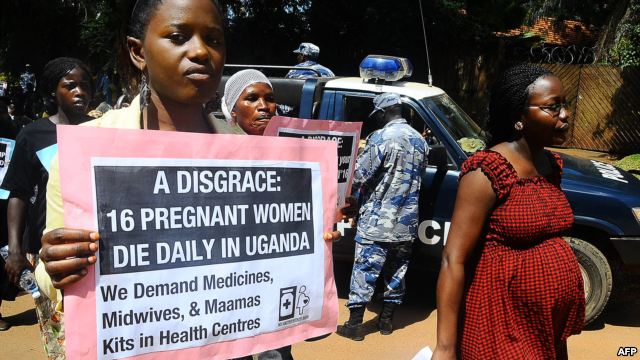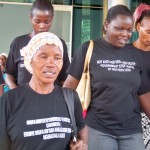By Mark Omara
“If government cannot protect the welfare of women, as it relates to the delivery of adequate maternal healthcare, then it is indeed a sad day in Uganda.”
This question is a legitimate and an important question, particularly in light of recent astonishing developments with regards to issues of maternal and child healthcare in Uganda. Three stunning stories will elucidate the prevalence and magnitude of this monumental healthcare issue.
On Monday, July 9, 2012, Hajara Katusabe, a 24-year old expectant mother in Kibaale District was rushed to Isunga Health Center III in the wee hours as relatives frantically sought help from a resident midwife. Their arrival at the compound of the health center went unanswered as the midwife allegedly defied repeated pleas to arise and help the woman in labor, claiming fatigue from a heavy workload the previous day. Ms Katusabe eventually died as she fidgeted to give birth on her own, a sad development that drew the ire of local residents who turned out in droves with the intent to deliver a swift justice to an apparent “soporific, heartless and inept midwife.”
In December 2010, Jennifer Anguko slowly bled to death right in the ward of Arua Hospital. During the 12 hours of incessant bleeding due to complications of childbirth, not one doctor or nurse attended to her. Her husband, Valente Inziku, frantically changed her blood-soaked bed clothes as her life seeped away. “From the time when she arrived at the hospital at 9 a.m. up to the time when she died, she was not even asked anything by one of the nurses or any medical personnel. The nurses were just passing by,” said Anguko’s husband Valente Inziku.
The deaths of Ms. Anguko and another woman, Sylvia Nalubowa, were the catalyst for a lawsuit that was filed in March by the Center for Health, Human Rights and Development (CEHURD), a Ugandan nonprofit group. The landmark lawsuit contended that the Ugandan government violated the two women’s rights to life by failing to provide them with basic maternal care, and sought a declaration from the Constitutional Court to that end.
Ms.Nalubowa’s ordeal in a decrepit Mityana Hospital is particularly illuminating as nurses reportedly demanded a bribe of about Ush60,000 ($24) to buy airtime for a cellphone call to the doctor. Unable to pay the bribe, Ms. Nalubowa was taken to the maternity ward and left unattended, where she bled to death.
Following the lawsuit filed against the government of Uganda for alleged denial of women’s rights to maternal care, the attorney general’s office replied that the “isolated” acts cited in the case “cannot be used to dim the untiring efforts in the Health Sector.” The Constitutional Court eventually threw out the case on June 5, 2012, arguing that upholding the petition would have forced judges to wade into a political issue that was outside their jurisdiction. The petition’s supporters plan to appeal.
Are Ms. Katusabe’s, Ms. Anguko’s and Ms. Nalubowa’s deaths just outliers in an otherwise robust maternal healthcare in Uganda, or are these two experiences indicative of the average Ugandan’s experience as concerns maternal healthcare? It will be informative to take a look at the facts.
Maternal Healthcare Challenges in Uganda
There is a severe shortage of trained midwives and other health workers countrywide (14 health workers per 10,000 people, substantially lower than the WHO recommended number of 23 per 10,000). At most regional hospitals, almost half the positions for doctors are vacant, representative of a shortfall of 25,000 staff. Such extremely low patient-doctor ratios ensure that the physicians on duty will have to work several long hours in a day to meet the demand for healthcare services. One midwife reportedly worked alone and on-call for five months without a break. Under such enormous workload, the consequential midwife’s fatigue, for example, could drive noticeable tardiness in delivering patient care services, further making the healthcare experience deplorable for everyone.
A majority of clinics and hospitals regularly runs out of essential medicines, while only a third of facilities delivering babies are equipped with basics like scissors, cord clamps, and disinfectants, according to a 2010 Ministry of Health Report. Just 1 in 20 facilities has a vacuum extractor for assisted vaginal delivery, whereas a slightly higher number of 1 in 10 facilities have a dilation and curettage kit which is particularly essential for removing a retained placenta.
The quality of maternal services in the 12 regional referral hospitals have not kept pace with the increasingly swelling Ugandan population, putting significant strains on essential hospital supplies, facilities and staff. One regional referral hospital typically handles obstetric emergencies for about 3 million people, but some, like Arua Hospital, routinely runs out of sutures to sew up women after Caesarean sections.
In addition, according to a 2010 World Bank Report on the health services indicators in Uganda, the number of hospital beds per 1,000 population has plunged from a high of 1.65 in January 1976 to 0.39 in January 2008. It is not uncommon to see expectant mothers lying on mats in major hospital verandas while in labor, or overly crowded hospital wards that is indicative of the surge in the number of poor people seeking free medical help. The United Nations estimates that Uganda’s population will almost triple to 94 million, with tens of millions more babies to be delivered. It remains to be seen if any substantial effort will be dedicated toward ascertaining a commensurate improvement in maternal healthcare.
Rampant electricity blackouts continue to jeopardize critical life-saving procedures to help expectant mothers in major hospitals. Indiscriminate load shedding that are routinely carried out by Umeme, the major power company in Uganda, to purportedly save money from high energy use, undermine patient health outcomes in several affected hospitals. Even worse, just a paltry 1 in 4 health facilities countrywide has electricity or backup generators with adequate fuel routinely available during service hours, according to a Ministry of Health report.
Such a dismal infrastructure record was recently lambasted by Primah Kwagala, a lawyer for the Center for Health, Human Rights and Development when CEHURD filed a complaint against Umeme: “How honestly do you expect a worker to perform C-Sections on a mother who is suffering obstructed labor if there is no electricity to sterilize instruments, or even light to see if it is in the night,” asks Kwagala. In Jinja Referral Hospital, it was reported that over 150 patients had died in a space of months due to an unreliable power supply and load shedding.
An important question to ask is this: “Why is Umeme routinely cutting off power supply to hospitals? When a patient dies as a result of an intentional power blackout, who owns the responsibility for his death?” CEHURD deserves credit for highlighting this important issue that not only affects expectant mothers, but all patients countrywide.
It is also interesting to look at the annual earnings of health workers in Uganda, and how that plays out in the debate concerning maternal healthcare in Uganda. In the 2009/10 financial year, the monthly salary of a newly recruited medical officer stood at about Ush650,000 ($265) and the starting salary of a senior doctor at around Ush840,000 (or $342); the entry level salary for a registered nurse was about Ush354,000 ($145). The take-home pay for nurses and midwives was reportedly as little as Ush120,000 ($50).
This dismal salary structure—the lowest for any particular professional level in East Africa—hardly incentivizes medical personnel in Uganda, and is squarely responsible for an increasing exodus of skilled medical personnel out of the country “in search for greener pastures.” Ugandan medical personnel have used words like “inadequate, deplorable, unfair, and poor” to describe how they feel about their remuneration packages. As it is, a significant fraction of medical personnel winds up working two or three jobs just to make ends meet, with government employees also working in private clinics/hospitals.
An unfortunate consequence of this practice is the alleged disappearance of essential medicines and supplies from public hospitals that are ostensibly sold to private clinics and hospitals. Further, health worker’s fatigue resulting from moonlighting is responsible for several bad practices that include alleged rude behaviors towards patients and unexplained absences. In spite of this practice of moonlighting, there is an apparent insatiable desire to bribe patients who want a quicker access to healthcare, a practice that is prevalent in several hospitals, particularly in the countryside.
Another important figure of merit to look at is the out-of-pocket health expenditure, the percentage of private expenditure on health in Uganda. This expenditure includes any direct outlay by households, such as gratuities and in-kind payments, to health practitioners and supplies of pharmaceuticals, therapeutic appliances, and other goods and services whose primary intent is to contribute to the restoration or enhancement of the health status of individuals or population groups.
As Figure 1 shows, the percentage of individual Ugandans spending money out of their own pockets on health services dropped slightly from about 57% to 52% in the years 2000 to 2003, coinciding with the government’s decision to abolish patient fees in major hospitals at the turn of the millennium. Although the decision to abolish patient fees resulted into an increasing influx of poor patients seeking free access to healthcare, the out-of-pocket expenditures on health ticked up shortly after, reaching an astronomical high of 65% in 2006, and has remained steady at that rate since.
The immediate implications of this are clear: maternal mothers have got to spend huge sums of cash on stocking own supplies that hospitals routinely, inevitably runs out of—latex gloves, scissors, cotton wool, razor blades, antibiotics, etc. Thus, considering that about 35% of Ugandans live on less than $1.25 a day, it becomes incredibly difficult, if not downright impossible, for a mother with four kids in the countryside to stock up such expensive items in preparation for an impending childbirth. Add to this the unreliability and ineptitude of hospital services and you have a perfect formula for potential disaster at childbirth.
Maternal Mortality Ratio (MMR) in Uganda
The fifth millennium development goal (MDG) aims to improve maternal health, with the target of reducing the maternal mortality ratio (MMR) by 75% between 1990 and 2015. MMR represents the number of maternal deaths in a given period per 100,000 live births during the same period. According to WHO estimates, 10 countries have already achieved MDG 5, with reduction in mortality rates that fell between 76% (Viet Nam) and 95% (Estonia) by 2010. The WHO categorizes a high MMR as that which exceeds 300 deaths per 100,000 live births.
As might be expected, Sub-Saharan Africa had the highest MMR at 500 maternal deaths per 100,000 live births in 2010, while Eastern Asia had the lowest among MDG developing regions, at 37 maternal deaths per 100,000 live births. Chad and Somalia had extremely high MMRs (>1,000 maternal deaths per 100,000 live births) at 1,100 and 1,000, respectively. Uganda’s MMR stood at 310, with the lower and upper ends of the estimate at 200 and 500, respectively.
In 2010, 85% of the global burden of maternal deaths was borne by countries in Sub-Saharan Africa (56%) and Southern Asia (29%). Uganda was among those countries. About 5,200 women died from pregnancy-related causes in 2008, according to a recent University of Washington’s Institute for Health Metrics and Evaluation (IHME) study.
Figure 2. This chart shows the trends in maternal mortality ratios (maternal deaths per 100,000 live births) for the three East African countries from 1990 through 2010. For all three countries, MMR remain high at >300 maternal deaths per 100,000 live births.
Figure 2 shows the trends in estimates of maternal mortality ratios (MMR) by 5-year intervals, between 1990 and 2010, for the three East African countries: Uganda, Kenya and Tanzania. Among the three countries, Kenya is categorized as “making insufficient progress” towards achieving MDG 5; both Uganda and Tanzania are “making progress.” It is important to point out that all three countries had MMRs that exceeded 300, as of 2010. Some experts have put Uganda’s 2012 MMR at 450, suggesting that maternal mortality remains a persistent problem that needs an urgent redress. With the exploding population growth in Uganda, more women are at a significant risk of maternal deaths if current trends in maternal healthcare service delivery continue.
Is Government Spending Enough on Healthcare in Uganda?
All these grim statistics and facts bring into question what actions, if any, the government of Uganda has been engaged in to ameliorate a situation that has obviously gone awry. One of the complaints lodged against the government when CEHURD filed a lawsuit for alleged denial of women’s rights to maternal healthcare was that government was spending way less than what it promised to spend on maternal healthcare.
As experts see it, it is not like Uganda does not have sufficient funding and resources to tackle issues of maternal health. Since 2000, Uganda’s Health Sector Strategic plan has benefitted from direct donor support, accounting for 40% of Uganda’s health sector resources. The United States, for example, has donated $400 million annually as funding for the health sector.
But there has not been any increase in terms of the health sector’s proportional share within the annual budget, which has stagnated at about 10%. Moreover, in order to deliver the minimum healthcare package, the health sector needs an estimated $40 (Ush100,000) per capita per annum, according to experts. In the 2008/2009 financial year, the total public allocation to health per capita was a dismal $10.40 (Ush26,000), which is largely insufficient to meet population’s needs.
FIRED UP: Ugandan women activists carry signs outside the Constitutional Court building in May 2012, protesting the delay of a ruling in a landmark lawsuit regarding two women who bled to death while giving birth in Ugandan hospitals. The petitioners argue that by not providing essential medical commodities and health services to pregnant women, the government is violating the constitutional rights of Ugandans. CREDITS: The Associated Press in Kampala
The inadequate investment in maternal health has recently been described as contributing to an annual loss of about $112 million (or Ush275 billion), according to the United Nations Population Fund. Government has also tarnished its own reputation when it comes to public money as it has been plagued with a web of problems that include corruption and mismanagement of public funds, insensitive and wasteful spending on “trifles” such as the $700 million spent to acquire Russian-made fighter jets and military hardware in peacetime (last year), and the notorious entitlement spending on government ministers and members of Parliament.
Clearly, Uganda’s spending on maternal healthcare and healthcare in general is sorely insufficient, and is responsible, to a large degree, for the myriad problems that have plagued the nation’s healthcare sector. The government continue to pay lip service to propping up the nation’s healthcare funding, and as a result, more lives are lost daily because of poor healthcare.
The constitution of Uganda does not recognize explicitly maternal healthcare as a women’s rights issue. Chapter 4, Section 33, Subsection (2) of the Constitution states that “The state shall provide the facilities and opportunities necessary to enhance the welfare of women to enable them to realize their full potential and advancement.” If government cannot protect the welfare of women, as it relates to the delivery of adequate maternal healthcare, then it is indeed a sad day in Uganda.






